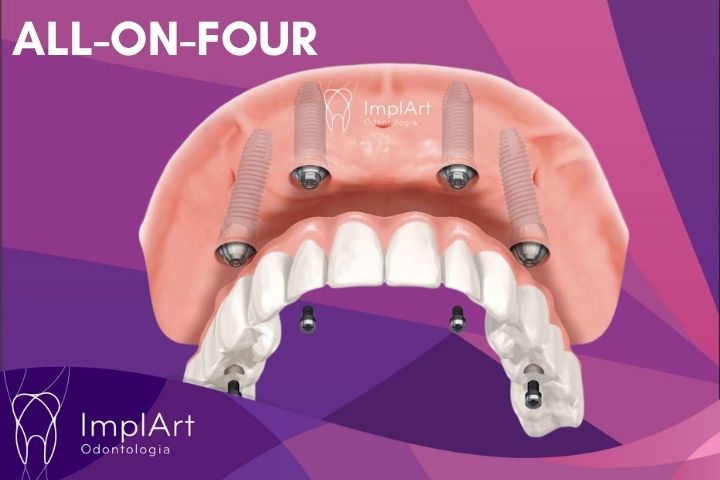
All on four or All on 4 implant technique
All on four is a technique for full-arch oral rehabilitation, i.e. restoring full dentition to those who have lost all the teeth in an arch. It is a much more comfortable and safer option than a mobile prosthesis (denture), as the fixed prosthesis is attached to 4 dental implants distributed throughout the arch, like a protocol prosthesis. The technique is more economical than a protocol prosthesis and has different characteristics. Find out more about the technique used at Clinica Dentaria ImplArt below and whether it is suitable for your case.
How does the All on 4 technique work? Is this technique right for me?
The All on 4 protocol consists of the surgical placement of 4 implant pins strategically distributed throughout the arch, followed by the fixing of a complete dental prosthesis.
The technique is generally indicated for people who have lost all their teeth in a full arch, upper or lower. Many of them wear mobiledentures and have advanced bone resorption(low bone volume), i.e. they have bone loss and are unable to place several dental implants in the arch.
We can therefore define the All on 4 technique as a dental implant alternative for people with little bone volume. Therefore, there is no need for bone grafts.
Another option for those with little bone volume is to use short or thinner implants, often avoiding bone grafting procedures.
We have performed over 1.000 cases of all-on-four implants since 2008, at ImplArt Clinic !
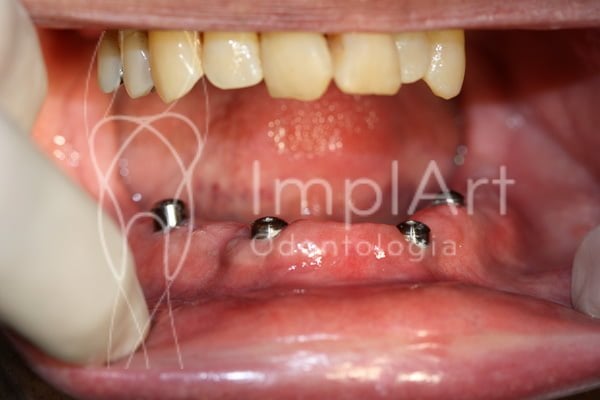
The choice of which technique is best for your case should be discussed between the patient and the dental surgeon, in consultation, after clinical and radiological assessment. Find out more about smaller dental implants here.
The immediate loading technique can be defined as one in which the prosthesis is fixed more quickly after the implants have been placed. Most of the time, on the same day.
One of the biggest concerns for those undergoing full-arch rehabilitation with dental implants is whether they will lose teeth at some stage during treatment. With the immediate loading technique, patients are not left without teeth while they recover.
What is the difference between the All on four technique and the traditional protocol prosthesis technique?
In the conventional technique, 6 dental implant pins are generally used throughout the arch to support the protocol prosthesis.
With the All on four technique, four dental implant screws are used, the two posterior ones being longer. They are placed at a greater angle than conventional implants, around 45°. The longer length of the post is intentional to increase the contact area between the implant surface and the bone. This reduces the need to recreate a vertical bone augmentation through bone grafting surgery.
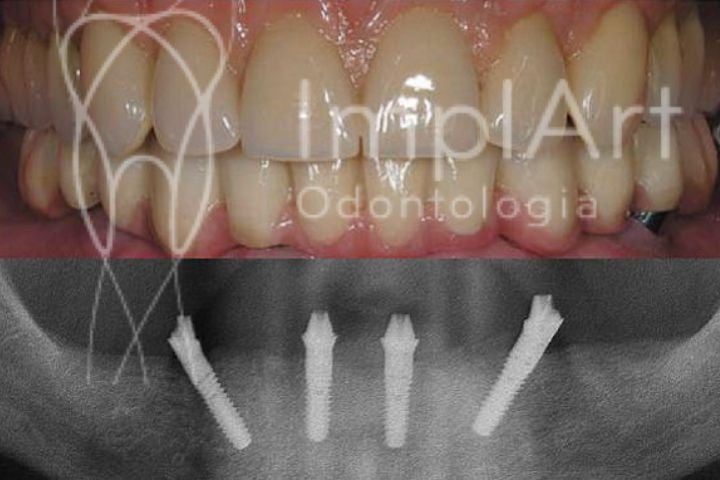
As well as increasing the contact area, the use of longer, tilted implants allows them to be placed in a stronger portion of the bone, so that they are securely attached.
Eventually, someone might ask whether this technique would be less efficient than the conventional one, imagining that the load distribution on 4 implants would be greater than 6 pins, for example.
Biomechanical studies show that tilted implants, when they are part of the prosthetic support, have no negative effect on load distribution. Implant tilting has been used in clinical practice for over a decade and has shown favorable results.
Advantages of total prosthesis on All-on-4 implants compared to dentures:
- The dental prosthesis is stable because it is attached to the implants. This makes speaking and chewing more comfortable and secure. With a mobile prosthesis, the wearer may feel their prosthesis is unstable.
- Dental implants are, in most cases, able to maintain bone volume. In contrast to implant-supported dentures, mobile dentures are unable to prevent bone loss and, as a result, the bone can become thinner and smaller. This is also one of the factors that makes dentures loose due to maladjustment.
- The aesthetics of the prosthesis for rehabilitation in undoubtedly much better than a mobile prosthesis. Ceramics, applied zirconia and pure zirconia are advanced technology materials that more faithfully reproduce the characteristics of human teeth, for example, strength, shine, translucency, shades and textures, whereas mobile prostheses are made of acrylic or resin, materials that scratch, fracture and stain more easily.
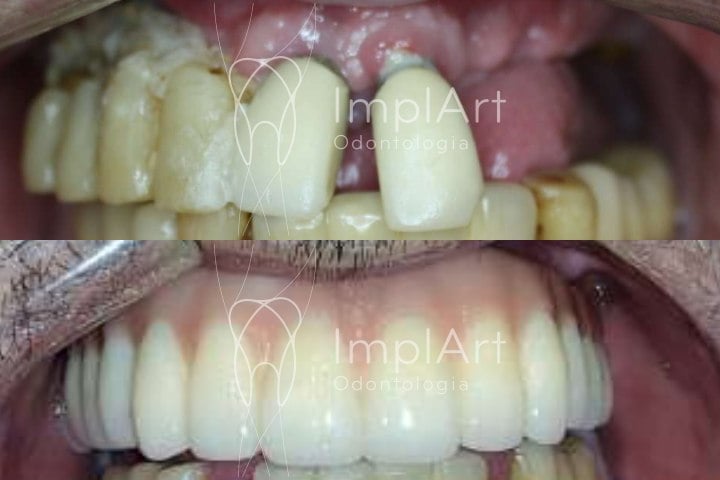
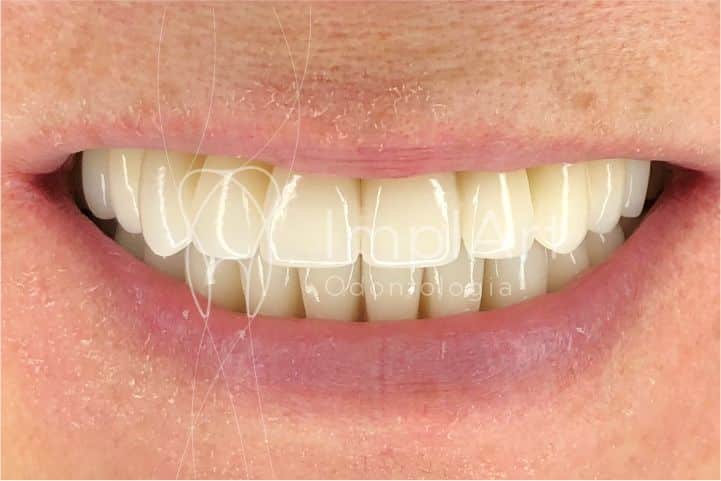
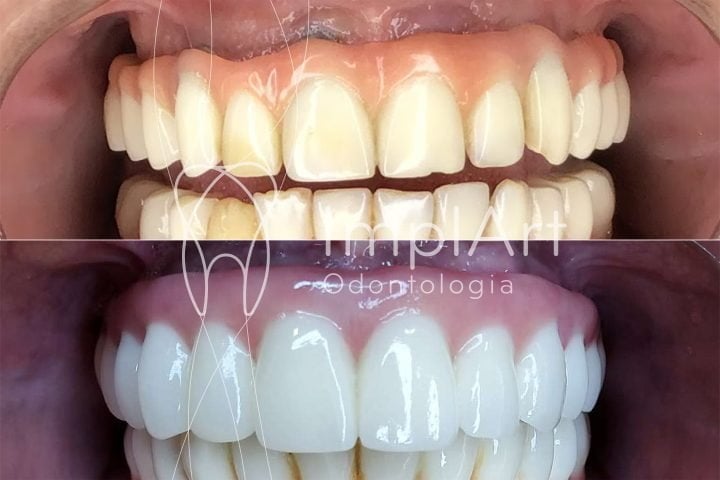
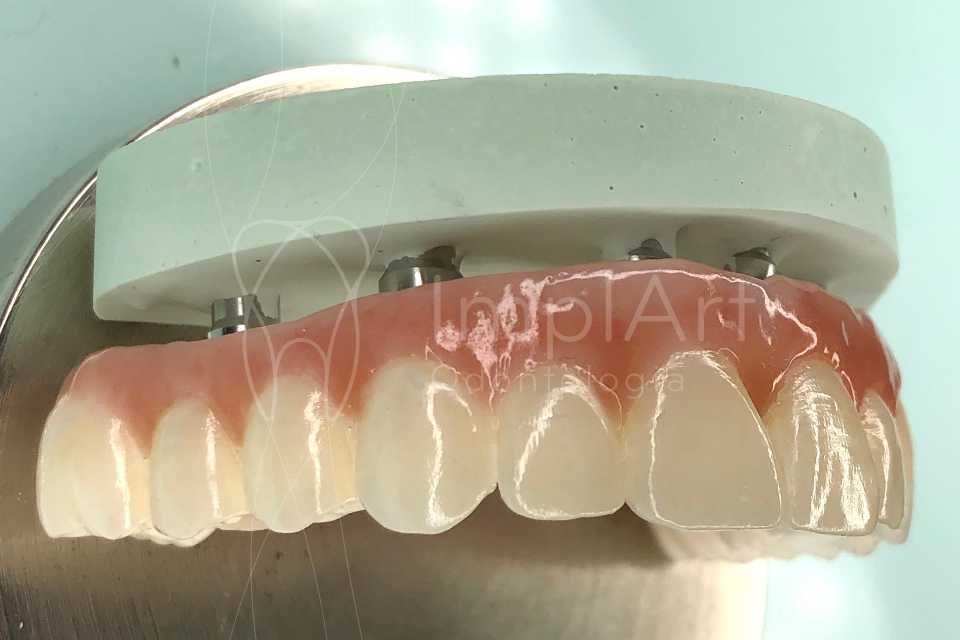
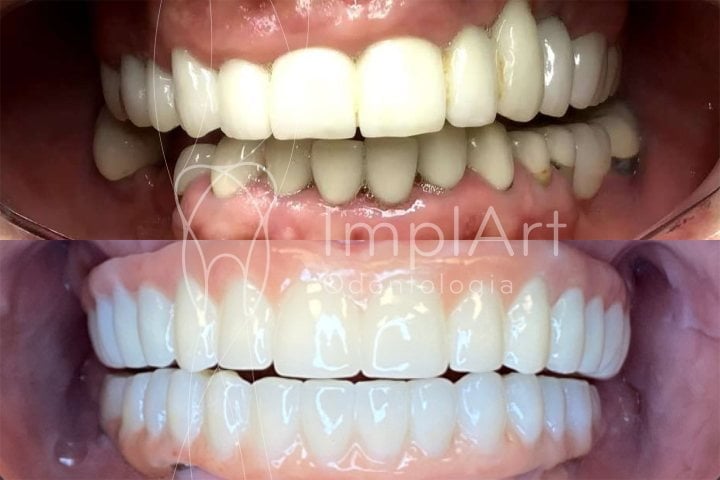
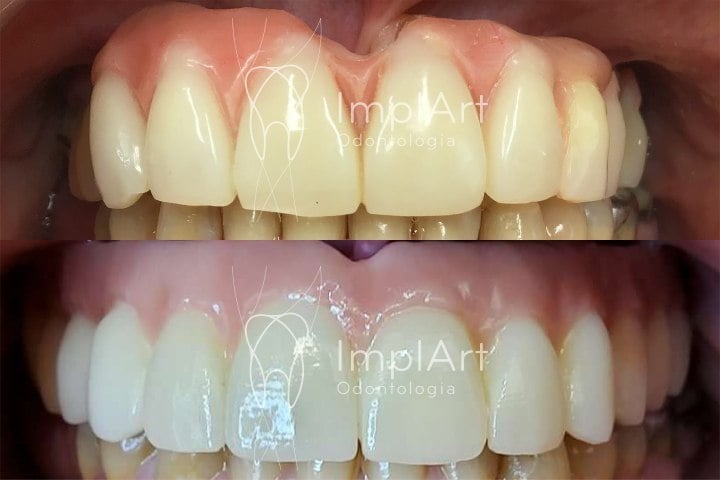
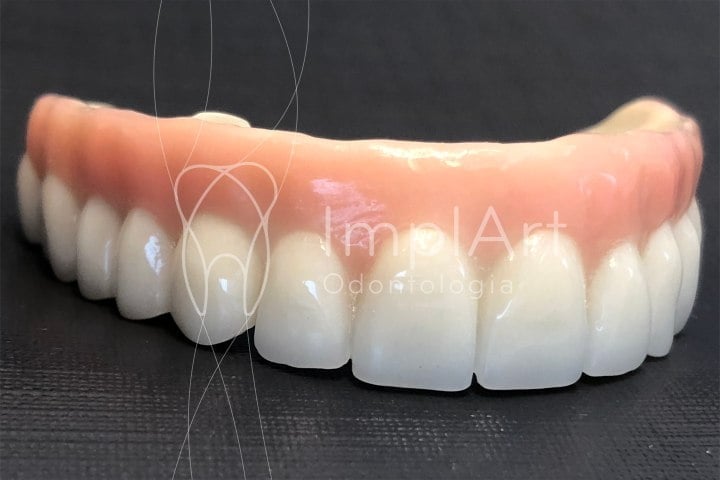
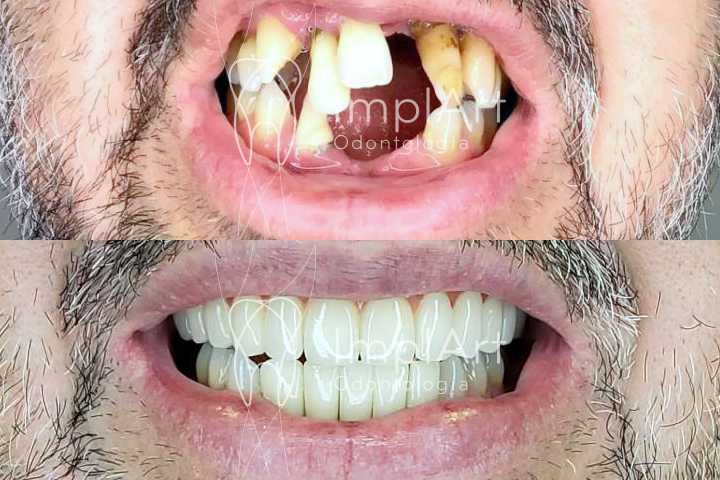
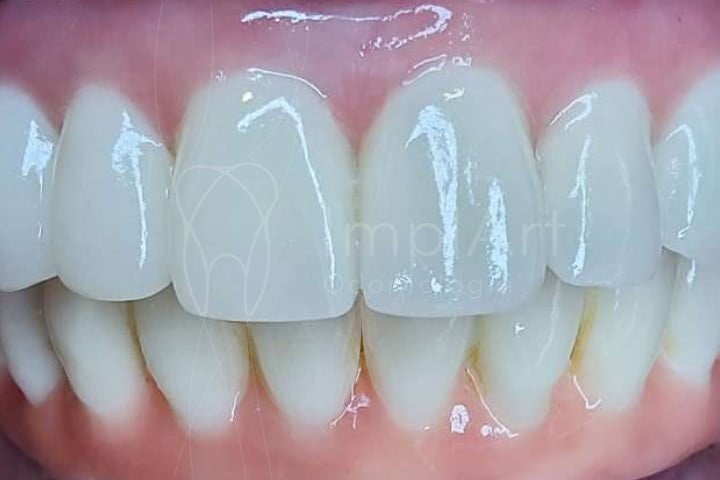
Computer-guided implants for less invasive surgery and faster recovery
Rehabilitation with All on 4 implants is best performed using computerized planning, better known as guided implant surgery.
Due to the limited bone volume, we perform a CT scan to accurately measure the width and height of the available bone. With this information, it is much easier to choose implants with diameters and lengths appropriate to the volume, as well as to choose the areas with the best conditions for insertion.
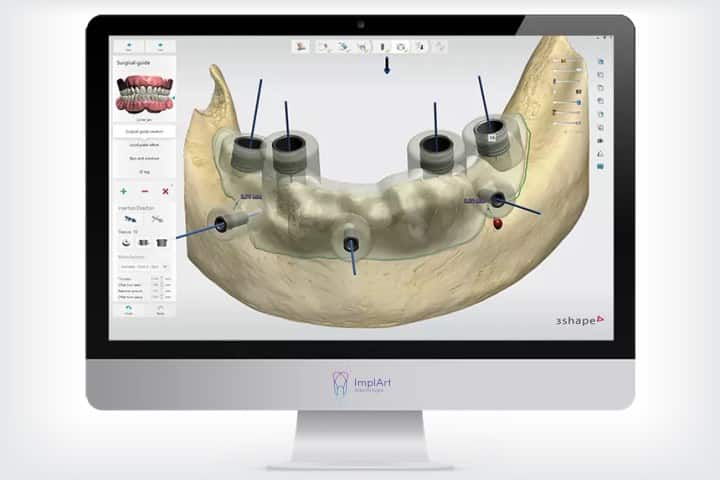
Once the measurements of the implants have been defined, as well as the positions in which they will be placed, we make a plastic guide that will serve as a surgical template.
Guided surgery for implants favors minimally invasive procedures, without making extensive cuts in the gums because surgical access is through small holes in the gums. The surgical guide ensures the guided and precise placement of osseointegrated implants.
Types of implant prostheses All on 4
The ultimate prosthetic solutions for All on four:
- Fixed dentures with acrylic coating
- Ceramic protocol prostheses (porcelain)
- Total rehabilitations in applied zirconia
- Aesthetic prosthesis in translucent pure zirconia
- Removable dentures, acrylic overdentures or overdentures are possible, but much less commonly used.
If you would like more information about the All on four technique, please contact us. We at the ImplArt Dental Clinic will be happy to assist you.
 Agende sua consulta agora por WhatsApp
Agende sua consulta agora por WhatsApp
Leave a Reply